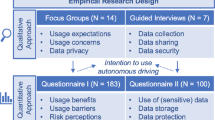Abstract
Computer science paradigms such as internet of things and ubiquitous computing has led to the increase of data and information available for use in innovative projects. Smart cities are planned to harness the strengths of these technologies towards the benefit of society. In the case of urban transport, there are new opportunities for information dissemination and driving and traffic flow analysis. Smart devices, are an adequate choice to ubiquitously gather and transmit data unobtrusively. This fuels the opportunity to handle these data as an input for data analysis and fusion processes that discover and aggregate new information to notify users and communities of incorrect practices, thus aiming to effect behavioural change and intelligent planning. The PHESS driving platform is presented as a response to these requirements and as a realization of some of the potentials for ubiquitous computing in smart cities. Although, there are alternatives, this approach focuses on individual and community driving analysis, which differentiate it from other approaches.



Similar content being viewed by others
References
André M (1996) Driving cycles development: characterization of the methods. Tech. rep, INRETS
Benamar N, Singh KD, Benamar M, El Ouadghiri D, Bonnin JM, Ouadghiri MDE, Bonnin JM (2014) Routing protocols in vehicular delay tolerant networks: a comprehensive survey. Comput Commun 48:141–158
Cerf V, Burleigh S, Hooke A, Torgerson L, Durst R, Scott K, Fall K, Weiss H (2007) Delay-tolerant networking architecture. RFC 4838
Eren H, Makinist S, Akin E, Yilmaz A (2012) Estimating driving behavior by a smartphone. In: 4th intelligent vehicles symposium, pp 234–239
Ericsson E (2001) Independent driving pattern factors and their influence on fuel-use and exhaust emission factors. Transp Res Part D Transp Environ 6(5):325–345
Fall K (2003) A delay-tolerant network architecture for challenged internets. In: Applications, technologies, architectures, and protocols for computer communications, ACM, pp 27–34
Flach T, Mishra N, Pedrosa L, Riesz C, Govindan R (2011) CarMA. In: 9th ACM conf. on embedded networked sensor systems—SenSys ’11, ACM, p 135
Fortino G, Giannantonio R, Gravina R, Kuryloski P, Jafari R (2013) Enabling effective programming and flexible management of efficient body sensor network applications. IEEE Trans Hum Mach Syst 43(1):115–133
Gong Y, Zhu Y, Yu J (2015) DEEL: detecting elevation of urban roads with smartphones on wheels. In: Sensing, communication, and networking
Hall M, National H, Frank E, Holmes G, Pfahringer B, Reutemann P, Witten I (2009) The WEKA data mining software : an update. SIGKDD Explor Newsl 11(1):10–18
Handel P, Skog I, Wahlstrom J, Bonawiede F, Welch R, Ohlsson J, Ohlsson M (2014) Insurance telematics: opportunities and challenges with the smartphone solution. Intell Transp Syst Mag IEEE 6(4):57–70
Healey J, Picard R (2005) Detecting stress during real-world driving tasks using physiological sensors. IEEE Trans Intell Transp Syst 6(2):156–166
Hull B, Bychkovsky V, Zhang Y, Chen K, Goraczko M, Miu A, Shih E, Balakrishnan H, Madden S (2006) CarTel: a distributed mobile sensor computing system. In: 4th Int. conf. on embedded networked sensor systems, ACM, pp 125–138
Johnson DA, Trivedi MM (2011) Driving style recognition using a smartphone as a sensor platform. In: 14th Int. IEEE Conf. on intelligent transportation systems, IEEE
Kuhler M, Karstens D (1978) Improved driving cycle for testing automotive exhaust emissions. Tech. rep., Volkswagenwerk AG, http://www.sae.org/technical/papers/780650
Lee U, Gerla M (2010) A survey of urban vehicular sensing platforms. Comput Netw 54(4):527–544
Mohan P, Padmanabhan VN, Ramjee R (2008) Nericell: rich monitoring of road and traffic conditions using mobile smartphones. In: 6th ACM Conf. on embedded network sensor systems, ACM
Paefgen J, Kehr F, Zhai Y, Michahelles F (2012) Driving behavior analysis with smartphones: insights from a controlled field study. In: 11th Int. conf. mobile and ubiquitous multimedia, ACM
Papadimitratos P, La Fortelle A, Evenssen K, Brignolo R, Cosenza S (2009) Vehicular communication systems: enabling technologies, applications, and future outlook on intelligent transportation. Commun Mag IEEE 47(11):84–95
Sanchez L, Galache JA, Gutierrez V, Hernandez JM, Bernat J, Gluhak A, Garcia T (2011) Smartsantander: the meeting point between future internet research and experimentation and the smart cities. In: Future network mobile summit, pp 1–8
Sentilant (2014) Drivian, http://www.drivian.com/
Seraj F, Zhang K, Turkes O, Meratnia N, Havinga PJM (2015) A smartphone based method to enhance road pavement anomaly detection by analyzing the driver behavior. In: Adjunct proceedings of the 2015 ACM Int. Joint Conf. on pervasive and ubiquitous computing and proceedings, ACM
Silva F, Analide C, Gonçalves C, Sarmento J (2014) Ubiquitous sensorization for multimodal assessment of driving patterns. In: Advances in intelligent systems and computing, vol 291. Springer, pp 143–150
Silva F, Analide C, Novais P (2015) Traffic expression through ubiquitous and pervasive sensorization. In: 5th Int. conf. on pervasive and embedded computing and communications systems
Watany M (2000) Variability in vehicle’ exhaust emissions and fuel consumption in urban driving pattern. Urban Transp Syst 187(1):31–38
Waze Ltd (2014) Waze, http://www.waze.com/
Acknowledgments
This work has been supported by CT-Fundação para a Ciência e a Tecnologia within the Project Scope UID/CEC/00319/2013.
Author information
Authors and Affiliations
Corresponding author
Rights and permissions
About this article
Cite this article
Silva, F., Analide, C. Ubiquitous driving and community knowledge. J Ambient Intell Human Comput 8, 157–166 (2017). https://doi.org/10.1007/s12652-016-0397-9
Received:
Accepted:
Published:
Issue Date:
DOI: https://doi.org/10.1007/s12652-016-0397-9




